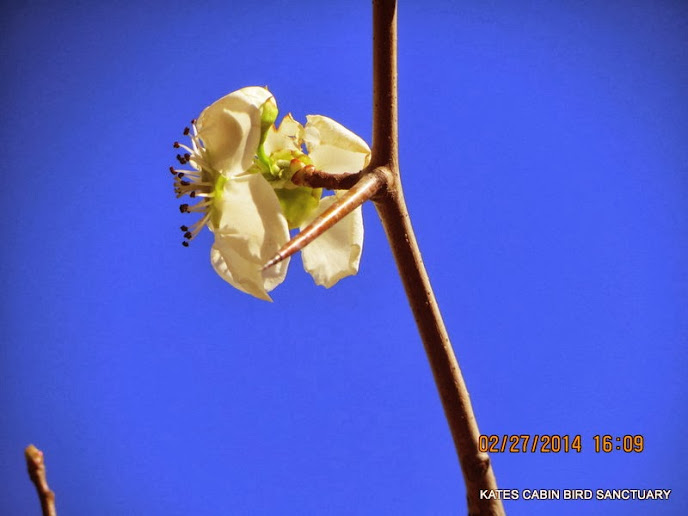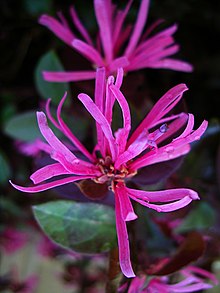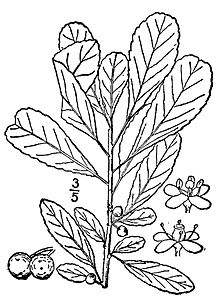
Hi Everybody!!
It is easy to add fruits and berries to your landscape as space permits. The small trees and shrubs will attract birds and butterflies with natural treats. Some you may like to eat also. I have shared below some pics from my yard and info from Wikipedia to give you an idea of what fruits the birds like. Of course, any further info you may want is a click away on Google Search.
I encourage everyone to grow some of your own food. It is good planning to have things around your yard (or patio) to eat. Celebrate the month of March by noticing what is blooming around you. Begin to think about a garden. Enjoy!!

Mayhaw

https://en.wikipedia.org/wiki/Mayhaw
Mayhaw
From Wikipedia, the free encyclopedia
Mayhaw is the name given to the fruit of the species of Crataegus series Aestivales[1]that are common in wetlands throughout the southern United States. The principal species are C. aestivalis, the eastern mayhaw, and C. opaca, the western mayhaw.[1]
Mayhaws grow in moist soil in river and creek bottoms under hardwood trees. The fruit ripens in late April through May, thus the name may-haw. The fruit is also found in bayoussurrounding lakes, such as Caddo Lake on the Texas/Louisiana border. Mayhaws are often collected out of the water from boats, and the fruit is used to make jelly.
Families used to go on outings to collect mayhaws and create stockpiles of the jelly to last throughout the year, but the tradition has declined with the increasing urbanization of the South and the destruction of the mayhaw's native habitat. The fruit has also been cultivated to grow outside of wetlands, and this is increasing the source of the jelly.
| Mayhaw | |
|---|---|
 | |
| Scientific classification | |
| Kingdom: | Plantae |
| (unranked): | Angiosperms |
| (unranked): | Eudicots |
| (unranked): | Rosids |
| Order: | Rosales |
| Family: | Rosaceae |
| Genus: | Crataegus |
| Series: | Aestivales (Sarg. ex C.K.Schneid.)Rehder |

Cherry Laurel (For the Birds)
https://en.wikipedia.org/wiki/Prunus_caroliniana
Prunus caroliniana
From Wikipedia, the free encyclopedia
Prunus caroliniana, known as the Carolina Cherry Laurel, with syns. Cherry Laurel,Carolina Cherry, Laurelcherry or Wild Mock Orange, is a flowering tree native to theSoutheastern United States, from North Carolina south to Florida and westward to easternTexas.[2] It was once classified as Laurocerasus caroliniana.[3] It is not to be confused with its European relative Prunus laurocerasus, which is also called Cherry Laurel, though mainly known as English Laurel in the U.S.
| Prunus caroliniana | |
|---|---|
 | |
| Scientific classification | |
| Kingdom: | Plantae |
| (unranked): | Angiosperms |
| (unranked): | Eudicots |
| (unranked): | Rosids |
| Order: | Rosales |
| Family: | Rosaceae |
| Genus: | Prunus |
| Species: | P. caroliniana |
| Binomial name | |
| Prunus caroliniana Aiton | |
 | |
| Natural range of Prunus caroliniana | |
Description[edit]
Prunus caroliniana is a small to medium sized evergreen tree which grows to about 8–13 m tall, with a spread of about 6–9 m. The leaves are dark green, alternate, glossy, coriaceous, elliptic to oblanceolate, 5–12 cm long, usually with an entire (smooth) margin, but occasionally serrulate (having subtle serrations), and with cuneate bases. The twigs are red to grayish brown, slender, and glabrous.[4] (Reproductively mature trees have entire margins, whereas immature ones often have serrations.[5])
The white to cream-colored flowers are produced in racemes (stalked bunches) 5–8 cm long in the late winter to early spring.[2] The fruits are tiny black cherries about 1 cm in diameter, which persist through winter and are primarily consumed by birds (Feb. - April).[5]

Link to Spring Photostudy:
https://plus.google.com/u/0/photos/117645114459863049265/albums/5985888614928380481

Chinese Fringe Flower (For the Butterflies)
https://en.wikipedia.org/wiki/Loropetalum
Loropetalum
From Wikipedia, the free encyclopedia
Loropetalum is a genus of 3 species of shrub in the witch-hazel family, Hamamelidaceae, native to China, Japan, and south-eastern Asia.
The name Loropetalum refers to the shape of the flowers and comes from the Greek loronmeaning strap and petalon meaning petal. Flowers are produced in clusters during spring and are similar to those of the closely related witch-hazel. Each flower consists of four to six (depending on species) slender strap shaped petals 1-2 cm long.
The species are:
- Loropetalum chinense - white-flowering variety up to 3.7 m tall, pink-flowering variety up to 1.5 m tall
- Loropetalum lanceum - up to 13 m tall, white flowers
- Loropetalum subcordatum - up to 12 m tall
| Loropetalum | |
|---|---|
 | |
| Loropetalum Chinense Rubrum | |
| Scientific classification | |
| Kingdom: | Plantae |
| (unranked): | Angiosperms |
| (unranked): | Eudicots |
| (unranked): | Core eudicots |
| Order: | Saxifragales |
| Family: | Hamamelidaceae |
| Genus: | Loropetalum |


Green Fruit of Eleagnus:

https://en.wikipedia.org/wiki/Elaeagnus
Elaeagnus
From Wikipedia, the free encyclopedia
| Elaeagnus | |
|---|---|
 | |
| Elaeagnus commutata | |
| Scientific classification | |
| Kingdom: | Plantae |
| (unranked): | Angiosperms |
| (unranked): | Eudicots |
| (unranked): | Rosids |
| Order: | Rosales |
| Family: | Elaeagnaceae |
| Genus: | Elaeagnus L. |
Description[edit]
Elaeagnus plants are deciduous or evergreen shrubs or small trees. The alternate leavesand the shoots are usually covered with tiny silvery to brownish scales, giving the plants a whitish to grey-brown colour from a distance. The flowers are small, with a four-lobed calyxand no petals; they are often fragrant. The fruit is a fleshy drupe containing a single seed; it is edible in many species. Several species are cultivated for their fruit, including E. angustifolia, E. umbellata and E. multiflora (gumi).
Other uses[edit]
E. umbellata is reputed to have a high amount of the carotenoid antioxidant, lycopene[6]and has been shown to display antioxidant properties effective against cancermechanisms in vitro.[7] E. multiflora is among the nutraceutical plants that Chinese use both for food and medicine.[citation needed] Both of these species have small but abundant tasty berries.
Ecology[edit]
Elaeagnus species are used as food plants by the larvae of some Lepidoptera species including Coleophora elaeagnisella and the gothic moths. The thorny shrubs can also provide good nesting sites for birds.

Helpful Info:
http://www.dummies.com/how-to/content/planning-to-grow-your-own-fruits-and-vegetables.seriesId-92324.html
Possumhaw (for the Birds):

https://en.wikipedia.org/wiki/Ilex_decidua
Ilex decidua
From Wikipedia, the free encyclopedia
| Ilex decidua | |
|---|---|
 | |
| Scientific classification | |
| Kingdom: | Plantae |
| (unranked): | Angiosperms |
| (unranked): | Eudicots |
| (unranked): | Asterids |
| Order: | Aquifoliales |
| Family: | Aquifoliaceae |
| Genus: | Ilex |
| Species: | I. decidua |
Description[edit]
Distinguishing features of this species arecrenate leaf margins and fruiting pedicels that are 2–8 mm long.[1] Its "distinctive leaf shape... is less variable than other species of holly".[2]Leaves are obovate,[3] simple, alternating,deciduous, and grow to 2.5-7.5 cm long.[2]
Drupe fruits are red (or rarely yellow), shiny, andglobose (spherical, or nearly so), with a diameter of 4–8 mm.[1][2] The pulp is bitter; they contain 3-5 seeds and mature in autumn.[2]
Slender twigs are glabrous and silvery gray, with "numerous spur shoots", pointed lateral buds, and acuminate scales.[2]
Distribution and ecology[edit]
Ilex decidua is a common plant,[1] growing in the US in Alabama, Arkansas, Washington, D.C., Florida, Georgia, Illinois, Indiana, Kansas,Kentucky, Louisiana, Maryland, Missouri,Mississippi, North Carolina, Oklahoma, South Carolina, Tennessee, Texas, and Virginia.[4]
It prefers land in floodplains and the margins of swamps or lakes, and grows at elevations up to about 360 m.[1][2] Other plant species with which possumhaw is associated include water tupelo (Nyssa aquatica), overcup oak (Quercus lyrata), bald cypress (Taxodium distichum), sycamore (Platanus occidentalis) and hackberry (Celtis spp.).[6]
Human use[edit]
Because of the attractive "berries", the tree is used as a winter ornamental plant, and branches are collected for use as Christmas decorations.[2] The wood is not useful commercially because of the tree's small size.[2]

...this is brendasue signing off from Rainbow Creek. See You next time!

O+O




No comments:
Post a Comment
Hi Everybody! Please say hello and follow so I know you are here! Due to the inconsideration of people trying to put commercials on my blog comment area, I have restricted use of anonymous posts. Sorry that some hurt all.
My public email is katescabin@gmail.com No spammers or trolls